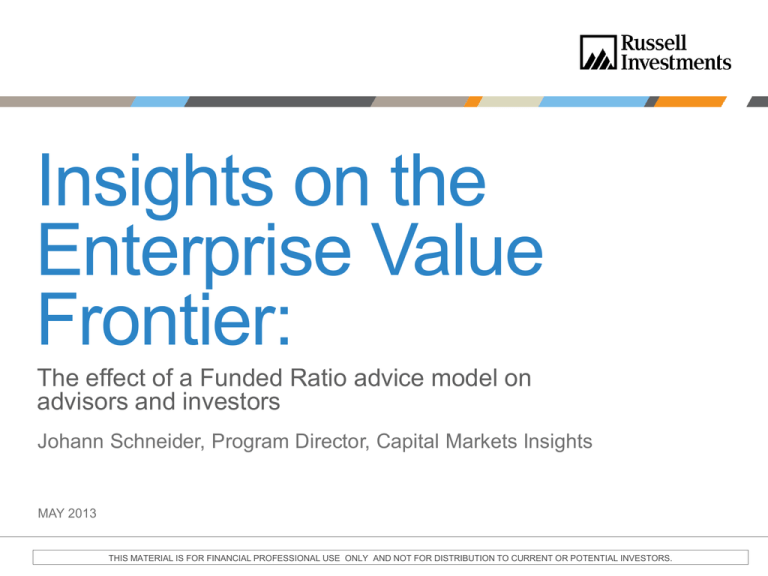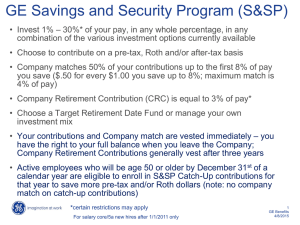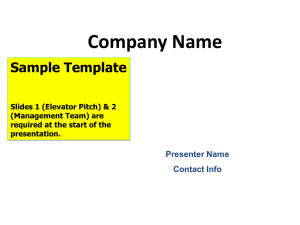
Insights on the
Enterprise Value
Frontier:
The effect of a Funded Ratio advice model on
advisors and investors
Johann Schneider, Program Director, Capital Markets Insights
MAY 2013
THIS MATERIAL IS FOR FINANCIAL PROFESSIONAL USE ONLY AND NOT FOR DISTRIBUTION TO CURRENT OR POTENTIAL INVESTORS.
Important Information and Disclosures
While all material in this presentation is deemed to be reliable, accuracy and completeness cannot be guaranteed. The information, analysis, and opinions
expressed herein are for general information only and are not intended to provide specific advice or recommendations for any individual or entity.
The information, analyses and opinions set forth herein are intended to serve as general information only and should not be relied upon by any individual or entity
as advice or recommendations specific to that individual entity. It is not intended to constitute legal, tax, securities, or investment advice, nor an opinion regarding
the appropriateness of any investment, nor a solicitation of any type. Anyone using this material should consult with their own attorney, accountant, financial or
tax or consultants on whom they rely for investment advice specific to their own circumstances.
Some information shown is based on assumptions. Expected returns employ proprietary projections of the returns of each asset class. We estimate the
performance of an asset class or strategy by analyzing current economic and market conditions and historical market trends. It is likely that actual returns will vary
considerably from these assumptions, even for a number of years. References to future returns for either asset allocation strategies or asset classes are not
promises or even estimates of actual returns a client portfolio may achieve. The assumptions do not take fees into consideration and all returns are assumed
gross of fees. Asset classes are broad general categories which may or may not correspond well to specific products. Opinions and estimates offered constitute
our judgment and are subject to change without notice, as are statements of financial market trends, which are based on current market conditions. This material
is not intended as an offer or solicitation for the purchase or sale of any financial instrument.
Russell Investment Group is a Washington, USA corporation, which operates through subsidiaries worldwide, including Russell Investments, and is a subsidiary
of The Northwestern Mutual Life Insurance Company.
Copyright© Russell Investments 2013. All rights reserved. This material is proprietary and may not be reproduced, transferred, or distributed in any form without
prior written permission from Russell Investments. It is delivered on an “as is” basis without warranty.
Russell Financial Services, Inc., member FINRA, part of Russell Investments.
First used: May 2013.
RFS 13-10787
p.2
FINANCIAL PROFESSIONAL USE ONLY
Staying on course:
Successful navigation requires constant recalibration
So does planning for retirement
Destination
Lost at
sea
GPS
Sailboat
p.3
FINANCIAL PROFESSIONAL USE ONLY.
A hypothetical example
High
Illustration of client course correction
Original Plan
Without adjustment
Course correction
Client Wealth
Without making adjustments,
the client never recovers;
Recognize shortfall, increase
savings at age 55, to get
back on track by age 65
Asset longevity suffers
Low
Bad performance
knocks client off-track
25
30
35
40
45
50
55
60
65
70
75
80
85
90
95
100
105
110
115
Client Age
This hypothetical example is for illustration only and does not represent the experience of any one investor. A different set of assumptions could produce
different results.
p.4
FINANCIAL PROFESSIONAL USE ONLY.
Thesis
› Implementing a systematic advice process that reacts
dynamically to unexpected market events may allow
advisors to improve retirement success rates for their
clients
› What is good for clients may be good for advisors;
implementing a Funded Ratio Targeting (FRT) advice
process may increase the enterprise value of advisory
firms
May lead to
Advice Process
p.5
Better Retirement
Outcomes
May lead to
Investor
FINANCIAL PROFESSIONAL USE ONLY.
Increase Enterprise
Value
Advisor
The Funded Ratio can help determine if an investor
is on course for successful retirement
› What is the investor’s actual retirement goal?
› Traditional accumulation strategies rely on targeting a tolerable level
of risk and maximizing return at that risk level
Try getting your clients
to understand this!
› For investors, risk is about running out of money before
running out of life
› Why not design a measurement that normal people care
about; one that answers the question: “Am I on track?”
p.6
FINANCIAL PROFESSIONAL USE ONLY.
The key is balancing
Assets and Liabilities
p.7
FINANCIAL PROFESSIONAL USE ONLY.
The funded ratio helps us do this
Funded Ratio
Assets*
Liabilities*
(Total Spending )
Surplus
Funded Ratio should
be measured at
frequent intervals
Not just at retirement
Assets*
Liabilities*
(Total Spending )
*Actuarial present value
p.8
FINANCIAL PROFESSIONAL USE ONLY.
Benefits of using the Funded Ratio as a foundation
for an advice process
› Truly outcome-oriented
› Specifically designed to measure investor’s ability to meet retirement
and spending goals (is your Funded Ratio > 1)
› Relies on ability to take risk, not willingness to take risk
› Institutional roots: “funded status” of pension plan
› Uses expected mortality rates, not expected year of death, to reflect
uncertainty
› Funded ratio is an indicator (or benchmark) that does not rely
on expected capital market returns
› It allows advisor and investor to focus on what they can control*:
saving, spending, date of retirement
› It tells them if gaining market exposure is necessary to meet goals
(if FR is low prior to retirement date)
*The Russell Retirement Lifestyle Solution Planner actually creates dynamic asset-allocation portfolios that attempt to dynamically adjust asset allocation
based on investor’s funded ratio and market expectations. The proposed advice process does not consider this aspect of the process, nevertheless,
employing the asset-allocated portfolios based on funded ratio should further improve investor success rates because they are flexible and responsive to the
current market environment
p.9
FINANCIAL PROFESSIONAL USE ONLY.
Basic investor characteristics
(The assumed investor utility function)
› #1: Wishes to be “ready” for retirement by start of age 65
Solution: Achieve Funded Ratio > 1.1 by age 65
› #2: Investor is willing to make reasonable sacrifices to
achieve retirement goals
Solution: Advise additional savings during accumulation to
help ensure priority #1 is met
› #3: Investor values return on investment; he desires
economic gain from savings burden in #2
Solution: Demonstrate an increased probability of
successful retirement; economic surplus at retirement & at
death
p.10
FINANCIAL PROFESSIONAL USE ONLY.
Distribution of expected wealth outcomes*
Millions
Even under with ideal planning circumstances, bottom quartile of
investors’ funded ratios fall short of 1 at time of retirement
$4.00
$3.50
$3.00
$2.50
$2.00
$1.50
$1.00
$0.50
$0.00
25
30
35
40
45
50
55
4.00
60
65
Client age
25%
70
50%
75
80
85
90
95
100
105
110
115
75%
Funded ratio
3.50
3.00
Investors who experience weak
performance (bottom quartile)
never achieve fully-funded status
2.50
2.00
This hypothetical example is
for illustration only and does
not represent the experience of
any one investor. A different
set of assumptions could
produce different results.
1.50
1.00
0.50
-
25
30
35
40
45
50
55
60
65
70
75
80
Client age
p.11
FINANCIAL PROFESSIONAL USE ONLY.
85
90
*See appendix for detailed
methodology
Distribution of expected wealth outcomes*
Millions
Using a prototype Funded Ratio Targeting approach to give advice, a
higher percentage of investors achieve sustainable retirements (FR>1)
$4.00
$3.50
$3.00
$2.50
$2.00
$1.50
$1.00
$0.50
$0.00
25
30
35
40
45
50
55
4.00
60
65
Client age
25%
70
50%
75
80
85
90
95
100
105
110
115
75%
3.50
Funded ratio
3.00
Improvement with FRT advice
process
2.50
This hypothetical example is
for illustration only and does
not represent the experience of
any one investor. A different
set of assumptions could
produce different results.
2.00
1.50
1.00
0.50
25
30
35
40
45
50
55
60
65
70
75
80
Client age
p.12
FINANCIAL PROFESSIONAL USE ONLY.
85
90
*See appendix for detailed
methodology
The Prototype* Funded Ratio Advice Process
On the client’s 45th birthday, measure client’s funded ratio, make modifications to
savings or spending plan for next 5 years, according to proceeding table. Repeat
process every 5 years.
Funded Ratio
(FR):
FR < 0.9
FR < 1.0
FR < 1.1
FR > 1.1
Age 45
Savings +10%
Savings +5%
Savings +2.5%
Funded
Age 50
Savings +10%
Savings +5%
Savings +2.5%
Funded
Age 55
Savings +10%
Savings +5%
Savings +2.5%
Funded
Age 60
Savings +10%
Savings +5%
Savings +2.5%
Funded
Age 65
Spending -15%
Spending -10%
Spending -5%
Funded
Age 70
Spending -15%
Spending -10%
Spending -5%
Funded
Age 75
Spending -15%
Spending -10%
Spending -5%
Funded
Age 80
Spending -15%
Spending -10%
Spending -5%
Funded
*This is a prototype because the FRT is not optimal and does not use a traditional consumption function to solve for the ideal
savings and spending rates. It is designed to keep investors on track for achieving a FR > 1.1 by the time they reach retirement and
to maintain a FR > 1.1 throughout retirement.
p.13
FINANCIAL PROFESSIONAL USE ONLY.
The probability of being fully funded improves under the FRT
advice process, satisfying investor characteristic #1
AT Retirement
Basic
Assumptions
FRT Advice
Process
Funded Ratio > 1.1
72%
85%
Funded Ratio > 1.0
64%
78%
(beginning of age 65)
72% of the 10,000 simulated wealth outcomes resulted in a Funded Ratio that was above goal (>1.1) using the basic assumptions (detailed
methodology in appendix). When applying the Funded Ratio Targeting approach to the same set of 10,000 investors, a full 85% had a FR > 1.1 at
retirement. A different set of assumptions could produce different results.
p.14
FINANCIAL PROFESSIONAL USE ONLY.
Does the process create value for the investor?
› Aligns entire advice strategy with investor’s lifecycle, rather than having a
different approach for accumulation and decumulation
› Systematic and consistent indicator advisors can use to analyze clients’ assets
and liabilities
› Reactive process that remains focused on outcomes and on what investors
can control
› Increase probability of achieving a funded ratio > 1.1 at retirement
Basic Assumptions
FRT Advice Process
Success Rate*
71.4%
82.5%
Median Surplus at Retirement^
11.2x Final Salary
12.6x Final Salary
Median Surplus at Death^
3.7x Final Salary
5.4x Final Salary
Median Age when money runs out&
94
99
Median Retirement Gain**
0.27x Final Salary
Median Lifetime Gain**
0.21x Final Salary
*Success is defined as situation where investor has enough retirement funds to last through entire lifetime
^Surplus defined as multiple of final salary, using value of dollars at retirement date in order to compare to final salary
& Median Age (the longevity extension is more significant for investors “on the bubble” (as illustrated earlier)
**Gain compares the increase in wealth at the time of retirement (or death) minus the additional cost of making extra contributions (and the cost of reducing distributions)
A different set of assumptions could produce different results.
p.15
FINANCIAL PROFESSIONAL USE ONLY.
A win for the investor may be a win for the advisor
› Higher profitability: Selective increase in investor
savings and reduction in spending increase advisors’
ability to collect revenue
› Marginally higher growth (of current assets): Marginal
positive impact for advisors
› Potential for more sustainable profits: Lower discount
rate may be justified because future profits are more likely
and process is more consistent
p.16
FINANCIAL PROFESSIONAL USE ONLY.
Higher profitability due to selective increases in
savings and reduction in spending
› Use “early ensemble” advisor archetype* to model profits generated
from book of clients being advised with the basic and FRT advice
approach
› An advisor whose average client age is 55 may generate 10% more
profits** using an FRT advice process
Average Profit in Year
(Avg Client Age = 55)
$280,000
$260,000
$240,000
$220,000
10%
gain
$200,000
$180,000
$160,000
$140,000
$120,000
$100,000
Base
FRT Advice
*InvestmentNews / Moss Adams: Early Ensemble characteristics from 2012 Financial Performance Study of Advisory Firms
Recreate advisor books of business by populating the book with the appropriate number of clients (165) from the investor simulations and using ROA to
estimate revenue, using pretax profit margin to estimate profit.
This hypothetical example is for illustration only and does not represent the experience of any one advisory firm. A different set of assumptions could
produce different results.
p.17
FINANCIAL PROFESSIONAL USE ONLY.
As investors age, the benefit of having used an FRT
advice process may increase
Average increase in profitability under FRT approach at different
client ages
20.0%
17.0%
15.3%
14.0%
13.1%
11.4%
11.0%
10.0%
8.6%
8.0%
5.0%
50
55
60
65
70
Average Age of Clients
Client lists were generated for the model advisor by pulling randomly from the 10,000 investor iterations and setting initial ages at 5 year intervals with a
standard deviation of 8 years. 1000 iterations of the advisor model were run at each age level to balance effects of having a representative percentage of
“underfunded” clients. This hypothetical example is for illustration only and does not represent the experience of any one investor. A different set of
assumptions could produce different results.
p.18
FINANCIAL PROFESSIONAL USE ONLY.
Profit growth increases modestly
› Growth increases modestly, due to a small percentage of
clients who save more in accumulation or spend less in
decumulation in order to maintain funded ratios above 1.0
Average Growth (next 5 years, annualized)
(Avg Client Age = 55)
11.0%
10.9%
10.8%
10.7%
10.6%
10.5%
10.4%
10.3%
10.2%
10.1%
10.0%
1.00%
10.7%
Average increase in growth under FRT approach
at different client ages
0.80%
0.60%
0.40%
10.5%
0.40%
0.29%
0.28%
50
55
0.43%
0.32%
0.20%
0.00%
Base
FRT Advice
60
65
Average Age of Clients
70
This hypothetical example is for illustration only and does not represent the experience of any one advisory firm. A different set of assumptions could
produce different results.
p.19
FINANCIAL PROFESSIONAL USE ONLY.
Enterprise value expected to increase by about 11%, for
advisors whose clients’ average age was 55
Enterprise value estimate
Average client age = 55
$1,400,000
$1,300,000
$1,262,174
$1,200,000
$1,138,167
+11%
$1,100,000
$1,000,000
Base case
FRT Advice Process
This hypothetical example is for illustration only and does not represent the experience of any one advisory firm. A different set of assumptions could
produce different results.
p.20
FINANCIAL PROFESSIONAL USE ONLY.
As clients age, enterprise value increases at a decreasing rate.
However, the increase in value from using the FRT advice process
continues to grow as clients age.
Expected enterprise value for Advisory businesses at
various average client ages
20%
$1,900,000
18%
Enterprise value ($)
$1,700,000
16%
$1,500,000
$1,300,000
14%
$1,100,000
12%
$900,000
10%
$700,000
10%
11%
12%
14%
17%
Avg Age 50
Avg Age 55
Avg Age 60
Avg Age 65
Avg Age 70
$500,000
8%
Increase in Value
Base case
FRT Advice Process
This hypothetical example is for illustration only and does not represent the experience of any one advisory firm. A different set of assumptions could
produce different results.
p.21
FINANCIAL PROFESSIONAL USE ONLY.
Increase in enterprise value (%)
$2,100,000
Conclusions
› A systematic and dynamic advice process creates value
for investors because it offers a reliable indicator of
whether they are on track for retirement
› Advisors may use the funded ratio, borrowed from
institutional pension investing, to objectively measure
clients’ readiness for retirement and make suggestions
about actions that may improve the chances of success
› Advisors may also benefit from incorporating a Funded
Ratio Targeting (FRT) advice process by increasing
potential profitability of clients, especially as they age
p.22
FINANCIAL PROFESSIONAL USE ONLY.
Appendix
FINANCIAL PROFESSIONAL USE ONLY.
Base case investor model assumptions
Lifecycle Phase
Age
Range
Contribution /
Distribution
Salary
growth
rate
Expected
Return*
1 – Accumulation
25 – 39
10% salary
4%
6.8%
15.6%
2 – Accumulation
40 – 54
15% salary
3%
6.3%
13.4%
3 – Accumulation
55 – 64
20% salary
2%
5.7%
10.5%
4 – Decumulation
65 – 115
85% final salary
(grow at inflation)
4.2%
4.8%
Investor Wealth (median)
$50,000
Social security coverage^
32% of Final Salary
Expected Inflation
2% constant
Expected Interest Rate
(for discounting Funded
Ratio)
3.5% (flat rate curve)
Mortality tables
For a male, probability of
surviving until certain age,
from retirement (ex: a
Social security coverage was estimated by projecting Bend
Points with these assumptions: from the SSA website
http://www.ssa.gov/oact/cola/bendpoints.html and using 2%
projected inflation to grow benefits. A higher expected starting
salary would lower amount expected from social security.
$2,500,000
$2,000,000
*Expected returns and risks are Russell’s capital markets
expectations for 4 models as of 3/31/2012: Equity Growth,
Growth, Moderate, Conservative. Details of the underlying
allocations are available upon request.
The model projects random returns around a lognormal return
distribution, based on the expected returns and risks stated
above.
$1,500,000
$1,000,000
Each iteration of the monte carlo simuation (10,000 total)
represents a different set of investor returns.
$500,000
$25 30 35 40 45 50 55 60 65 70 75 80 85 90 95 100 105 110 115
Client age
p.24
Starting salary
Expected
Risk*
FINANCIAL PROFESSIONAL USE ONLY.
The FRT advice process is detailed on slide 12: The model
uses the same returns, but adjusts savings and spending
rates according to the table – it is meant to demonstrate the
impact of using a different advice approach on the same
investor.
Advisor Assumptions
› Use # of clients, return on assets, pre-tax profit margin,
expected client growth from InvestmentNews / Moss Adams
2012 Financial Performance Study of Advisor Firms to generate
profitability and next 5 years growth for advisors.
› Assume tax rate of 35%, long-term growth rate of 5%, discount
rate of 25%.
› Look at advisors at different stages in career by generating
client books with average age 50, 55, 60, 65, 70. Standard
deviation: 8 years.
› Generate 1000 iterations for each age-group.
› Use average profitability, growth and discount rate to arrive at
enterprise value for each advisor-type.
› Use a 5 year discounted cash flow model that projects a
terminal value at the end of 5 years.
p.25
FINANCIAL PROFESSIONAL USE ONLY.
“Russell,” “Russell Investments,” “Russell 1000,” “Russell 2000,” and “Russell 3000”
are registered trademarks of the Frank Russell Company.
FINANCIAL PROFESSIONAL USE ONLY.
www.russell.com








